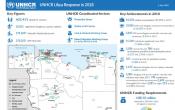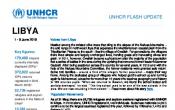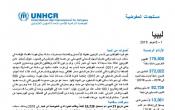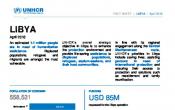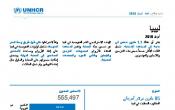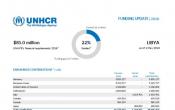Libya
Operation: Libya
Location
{"longitude":17,"latitude":27,"zoom_level":5,"iso_codes":"'LBY'"}
By clicking on the icons on the map, additional information is displayed.
Key Figures
| 2017 year-end results | |
| 100% | of all official detention centres were visited and monitored throughout the year |
| 49,240 | non-food items were distributed to refugees and migrants in detention centres and at disembarkation points |
| 28,320 | medical consultations were provided to refugees and migrants in detention centres and disembarkation points |
| 1,430 | refugees and asylum-seekers were released from detention following UNHCR’s advocacy efforts |
| 389 | detained refugees and asylum-seekers were evacuated through the ETM to Italy and Niger for forward solutions to a third safe place |
| 320 | people were referred for resettlement |
| 2018 planning figures | |
| 100% | of reception conditions will meet minimum standards |
| 100% | of people with disabilities will receive services for their specific needs |
| 100% | of refugees identified for resettlement will have their cases submitted for resettlement |
| 100% | of the identified and accessed detention conditions will meet minimum standards |
| 100% | of refugees identified at the disembarkation points, detention centres and in the CDCs will have access to primary health care |
| 100% | of refugees identified at the disembarkation points, detention centres and in the CDCs will have sufficient basic and domestic items |
Latest Updates
People of Concern
41%
Increase in
2016
2016
| 2016 | 662,897 |
| 2015 | 471,653 |
| 2014 | 399,935 |

[["Refugees",9310],["Asylum-seekers",29237],["IDPs",174510],["Returned IDPs",449840]]
Loading ...
Libya
< Back
2017
{"categories":[2013,2014,2015,2016,2017,2018],"budget":[18.29967982,19.0845059,20.43036002,23.865039,74.07170781,84.99999797],"expenditure":[6.72035615,7.31457152,8.54921236,12.12147176,44.15299434,null]}
{"categories":[2013,2014,2015,2016,2017,2018],"p1":[13.34674547,16.6945059,18.21231402,18.82037598,59.92643981,74.34143297],"p2":[2.16251618,0.34,null,null,null,null],"p3":[null,null,null,null,null,null],"p4":[2.79041817,2.05,2.218046,5.04466302,14.145268,10.658565]}
{"categories":[2013,2014,2015,2016,2017,2018],"p1":[6.09107143,6.90089752,6.71457381,9.79650861,33.18794716,null],"p2":[0.31574905,0.03065,null,null,null,null],"p3":[null,null,null,null,null,null],"p4":[0.31353567,0.383024,1.83463855,2.32496315,10.96504718,null]}
Loading ...
CHOOSE A YEAR
- 2015
- 2016
- 2017
- 2018
Operational context
The scope of protection and solutions for refugees and asylum-seekers in Libya remained limited throughout 2017. Refugees and migrants are exposed to risks and many have to endure long periods of detention. Therefore, UNHCR scaled up efforts in the areas of resettlement, complementary pathways, including family reunification and assistance for voluntary repatriation. By the end of 2017, UNHCR had found durable solutions for 710 refugees and asylum-seekers.Libya was the main point of departure for refugees and migrants using the central Mediterranean route from sub-Saharan Africa to Italy. Efforts to find lasting solutions for people of concern on the move were undertaken through the establishment of the emergency transit mechanism (ETM). A total of 389 extremely vulnerable asylum-seekers and refugees were evacuated from Libya; including 162 to Italy and 227 between November and December 2017. Some 320 refugees were referred to UNHCR’s protection service for resettlement. However, availability of resettlement slots remained limited. In September 2017, the High Commissioner called for an additional 40,000 resettlement places to be made available for refugees along the Central Mediterranean route.
Due to security constraints, access to IDPs remained challenging. Returnees and IDPs continued to face critical protection challenges and limited access to shelter, WASH, and other critical needs. Many medical facilities have been destroyed and essential medicines were often unavailable. Simultaneously, hundreds of thousands of people living in major cities continued to be at risk of serious injury due to explosive remnants of war.
Population trends
As of 31 December 2017, more than 45,000 refugees and asylum-seekers were registered with UNHCR. Syrian nationals composed the majority of the registered caseload (around 49 per cent) with smaller numbers from Eritrea, Ethiopia, Iraq, Palestine, Somalia and Sudan.In 2017, some 149,900 Libyan IDPs returned to their places of origin in Libya while 180,900 remained internally displaced. 27,000 IDPs were reported as newly displaced as a result of continued conflict.
Key achievements
In 2017, UNHCR expanded the scope of its operations to respond to the increasing humanitarian needs of refugees, asylum-seekers (urban and mixed movement), IDPs, returnees and host communities. More specifically, UNHCR:
- Expanded its protection monitoring from six to 12 disembarkation points. In addition, UNHCR and partners visited all 35 official detention centres in Libya throughout the year;
- Expanded refugee status determination (RSD) and resettlement (RST) capacity and increased its targets; some 320 refugees were referred for resettlement;
- Enhanced capacity for IDP protection through increased staffing and reporting; initiating monitoring tools; as well as internal and external advocacy for protection mainstreaming;
- Provided humanitarian assistance to IDPs and returnees: 61,300 IDPs and returnees received non-food items and 2,640 households received cash grants. In the east of the country, some 37,200 IDPs, returnees, and host community members were assisted: 25,940 people with non-food items and 11,290 people with cash assistance;
- Started the implementation of quick impact projects (QIPs) throughout Libya. QIPs are small, rapidly implementable projects intended to help create conditions for peaceful coexistence between those displaced and their hosting communities, strengthening the resilience of these communities. For example, UNHCR provided core-relief items for shelter reconstruction in Tawergha after a fire broke out;
- Provided cash and non-food items to 135,600 vulnerable people;
- Conducted 14 capacity-building trainings targeting 280 officials and partners;
- Enhanced coordination for the Protection Working Group through dedicated sector leads.
Unmet needs
- Access to all people of concern remained a challenge due to security restrictions, thus hampering UNHCR’s ability to reach all people in need. This includes both the humanitarian response to IDPs, refugees and other people of concern who often endure long periods of detention. Information and outreach systems to ensure better access to people of concern, especially in southern and eastern regions are needed.
- Mechanisms for reception and registration as well as legal assistance, documentation and civil registration of refugees and asylum-seekers need to be put in place. Resettlement opportunities for people of concern are needed with a view to support the most vulnerable refugees in Libya.
- Conditions for return of all IDPs in a safe, dignified and voluntary manner are not yet in place (i.e. housing, security) and did not therefore take place in 2017.
Working environment
Five years after the revolution, Libya remains politically divided and affected by heavy fighting across the country. The country is experiencing rising levels of insecurity and criminality, which creates an enabling environment for people smugglers to operate. Libya remains the main transit and departure point from North Africa towards Europe for migrants and refugees travelling as part of sixed movements.Despite limited humanitarian access, UNHCR maintains a presence in Libya and has resumed targeted registration and cash-based interventions. UNHCR, through its partners, also carries out monitoring at detention facilities run by Libyan authorities and at disembarkation points used following rescue at sea and interception incidents.
In 2017, UNHCR will continue to assist the some 38,000 asylum-seekers registered with UNHCR - mainly from Eritrea, the State of Palestine, and the Syrian Arab Republic, out of an estimated 100,000 refugees and asylum seekers in the country. In addition, UNHCR will support the provision of protection and assistance to the most vulnerable of the more than 313,000 internally displaced people and 463,000 displaced Libyans who return to their area of origin.
Key priorities
In 2017 UNHCR’s operation will focus on:• preventing refoulement;
• improving access to territory and asylum;
• providing humanitarian assistance and access to durable solutions, such as resettlement, to the most vulnerable people;
• advocating refugee protection and access to basic services; and
• enhancing coordination with other humanitarian stakeholders.
A funding shortfall in 2017 for the UNHCR operation in Libya would limit UNHCR’s capacity to register asylum-seekers and to conduct monitoring visits to detention centres. It could also result in the suspension of the distribution of core relief items and cash grants, which are currently provided to the most vulnerable.

